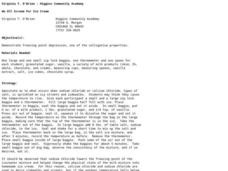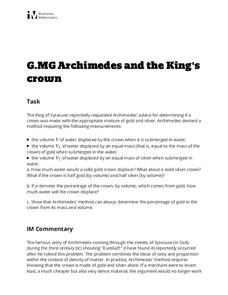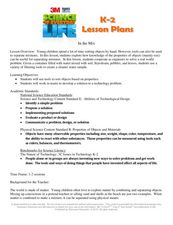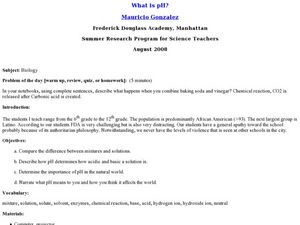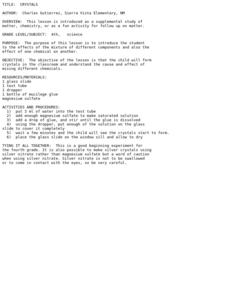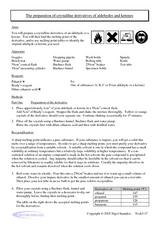Curated OER
Mixing It Up!
Third graders identify the different states of matter. In this science instructional activity, 3rd graders describe the different components of solutions and mixtures. They create emulsions, foams and suspensions in the lab.
Curated OER
Thermometric Titration Involving Dataloggers
In this thermometric titration worksheet, students determine the concentrations of hydrochloric acid and ethanoic acid using a titration where they measure the temperature of the solution as they titrate. The equivalence point is found...
Curated OER
Chemical Equilibria
In this equilibria learning exercise, students are given detailed information about LeChatelier's principle and how to solve equilibrium problems. They then calculate concentrations of compounds in solutions.
Curated OER
We All Scream for Ice Cream
Students investigate the freezing point depression of water while making ice cream. In this colligative properties lesson plan, students make ice cream using ice, salt and water to freeze milk and sugar. They measure the temperature of...
Curated OER
Bubbleology Mickey Mouse Style
Students investigate the effects of four different shaped wands and geometric shapes in a bubble solution. In this bubbleology lesson, the students build water and soap molecules. Students work in cooperative groups and conduct...
Curated OER
What Is In The Cup?
Students investigate the mixtures of solutions. They utilize cups filled with bases and acids. Students test and determine the pH of each cup. The multiple cups are compared to each other in order to chart acids and bases according to pH...
Curated OER
Physical Science: Bubble Prints
Students participate in a lab experiment involving soap bubbles and making bubble prints. They blow bubbles into the soap and add paint to make bubble prints. With extra time, they can play with a variety of bubble toys to see what...
Curated OER
Rate of Solution
Eighth graders determine the amount of agitation necessary to dissolve various sized sugar particles. This task assess students' abilities to collect, organize, and interpret data, create appropriate graphs, predict future events based...
Curated OER
Science: Quick Freeze
Learners observe an experiment of freezing point depression using club soda. Through observation, they note that the carbon dioxide molecules disrupt the capacity of the water molecules to solidify. Precautions must be taken to assure...
Illustrative Mathematics
Archimedes and the King's Crown
Learners will shout "Eureka!" in this quick but deep activity replicating the famous bathtub experiment of Archimedes. Given the scenario of a king with a suspected fake crown, young investigators develop formulas using density to...
Curated OER
Confectionary Bureau of Investigations: Case of the Cookie Mystery
Students perform tests on different chemicals to determine their chemical properties. In this forensic science lesson, students identify an unknown sample using its physical and chemical properties. They solve a fictional crime using...
Curated OER
In the Mix
Students construct a water filter. In this engineering lesson, students discover how to construct a water filtration system. Students work in groups to sort tools by their properties. Students analyze and construct a water filtration...
Curated OER
Making Soap
In this soap worksheet, students produce soap in the laboratory and test their product by washing away engine oil with their soap. Students answer four questions about tests they perform on their soap.
Curated OER
Chromatography - Chemical Separation of Colors
Third graders use the scientific method as they separate the colors used in ink. In this chromatography lesson, the teacher introduces students to how chromatography is used in several careers, then students perform an experiment to see...
Curated OER
States of Matter Mini-Unit
Students identify he phases of matter (solid, liquid, gas), and why they take place. They comprehend what a physical change is and what a chemical change is. Students know the difference between a Mixture and a Solution.
Curated OER
What is pH?
Students describe pH and the importance of it in the natural world. In this Biology lesson students compare the pH of different mixtures.
Curated OER
Crystals
Fourth graders use mucilage glue and magnesium sulfate to make crystals. They mix the ingredients, place a drop on a glass slide and observe the forming crystals.
Curated OER
Relating Moles to Coefficients of a Chemical Equation
High schoolers investigate the coefficients in a chemical equation and their relation to moles. In this moles and coefficients lesson plan, students perform a single replacement reaction of copper (II) sulfate and zinc and find the ratio...
Curated OER
Preparation of Crystalline Derivatives of Aldehydes and Ketones
Chemistry explorers prepare a crystalline derivative and find its melting point. Once they discover the melting point, they are able to identify whether or not the substance is pure, and whether it is an aldehyde or ketone. This is an...
It's About Time
More Chemical Changes
Generate entertainment by assisting students in creating multiple chemical changes during the course of small experiments integrated into one packed lesson. Individuals observe examples of chemical changes as they occur and gather data...
Curated OER
Programming the "Rinse Robot"
Experienced chemistry technicians use then layer chromatography to discover how much of a free compound is left after each rinse cycle. Where this could obviously be used as a practice with chromatography technique, it can also be used...
Curated OER
Weighted Averages
Weighted averages can be tricky to explain! However, this study guide makes it easy for teachers by including definitions, explanations, and breaking down problems into three steps. Includes mixture problems and uniform motion problems.
Teach Engineering
Surface Tension Lab
What constitutes a good soap bubble? In the second installment of a nine-part series, scholars apply their understanding of surface tension to soap bubbles. They experiment to determine the best solutions to use for the...
Curated OER
Matter And Its Changes
Fifth graders explore the phases of matter, make observations of matter, the physical and chemical properties of matter, solutions and mixtures, formation of molecules and atoms and molecules all through hands on activities.





